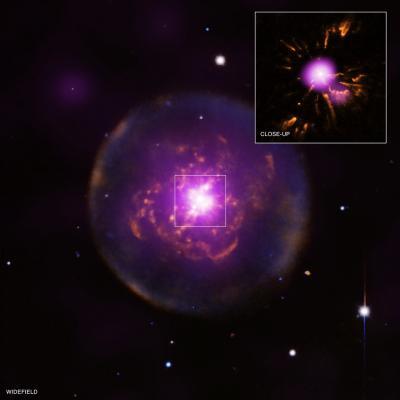Pasadena, CA— A team of astronomers including Carnegie's Daniel Kelson have set a new distance record for finding the farthest galaxy yet seen in the universe. By combining the power of NASA's Hubble Space Telescope, Spitzer Space Telescope, and one of nature's own natural "zoom lenses" in space, they found a galaxy whose light traveled 13.3 billion years to reach Earth. Their work will be published in The Astrophysical Journal.
Heavens
A tiny fraction of meteorites on earth contain strikingly beautiful, translucent, olive-green crystals embedded in an iron-nickel matrix. Called pallasites, these "space gems" have fascinated scientists since they were first identified as originating from outer space more than 200 years ago.
EUGENE, Ore. -- (Nov. 15, 2012) -- Using tiny radiation pressure forces -- generated each time light is reflected off a surface -- University of Oregon physicists converted an optical field, or signal, from one color to another. Aided by a "dark mode," the conversion occurs through the coupling between light and a mechanical oscillator, without interruption by thermal mechanical vibrations.
By combining the power of the NASA/ESA Hubble Space Telescope, NASA's Spitzer Space Telescope and one of nature's zoom lenses, astronomers have found what is probably the most distant galaxy yet seen in the Universe. The object offers a peek back into a time when the Universe was only 3 percent of its present age of 13.7 billion years.
We see the newly discovered galaxy, named MACS0647-JD, as it was 420 million years after the Big Bang. Its light has travelled for 13.3 billion years to reach Earth, which corresponds to a redshift of approximately 11 [1].

The intricate pattern of planetary nebula Abell 30 is revealed in these images that combine optical Hubble Space Telescope (HST) images with XMM-Newton and Chandra X-ray data.
These images of the planetary nebula Abell 30, (a.k.a. A30), show one of the clearest views ever obtained of a special phase of evolution for these objects. The inset image on the right is a close-up view of A30 showing X-ray data from NASA's Chandra X-ray Observatory in purple and Hubble Space Telescope (HST) data showing optical emission from oxygen ions in orange. On the left is a larger view showing optical and X-ray data from the Kitt Peak National Observatory and ESA's XMM-Newton, respectively.
The terms "black swan" and "perfect storm" have become part of public vocabulary for describing disasters ranging from the 2008 meltdown in the financial sector to the terrorist attacks of September 11. But according to Elisabeth Paté-Cornell, a Stanford professor of management science and engineering, people in government and industry are using these terms too liberally in the aftermath of a disaster as an excuse for poor planning.
Image of the Lafayette meteorite available from pressoffice@le.ac.uk
New research by the University of Leicester and The Open University into evidence of water on Mars, sufficiently warm enough to support life, has been published this week in the journal Earth and Planetary Science Letters.
In 2010, Tycho Brahe was exhumed from his grave in Prague, an event which received extensive international media coverage. Since then, a Danish-Czech team of researchers has been working to elucidate the cause of Tycho Brahe's death. The results of this intensive work now make it possible to rule out mercury poisoning as a cause of death.
For over four hundred years, Tycho Brahe's untimely death has been a mystery. He died on 24 October 1601 only eleven days after the onset of a sudden illness. Over the centuries, a variety of myths and theories about his death have arisen.
VANCOUVER, CANADA, NOVEMBER 15, 2012 -- It's time to economically value the greenhouse gas-trapping potential of mine waste and start making money from it, says mining engineer and geologist Michael Hitch of the University of British Columbia (UBC).
Hitch studies the value of mine waste rock for its CO2-sequestration potential, or "SP." He says mining companies across Canada will, in future, be able to offset CO2 emissions with so-named "SP rock," and within 25 years could even be selling emissions credits.
Georgia Tech, along with partner research organizations on the Keeneland Project, including the University of Tennessee-Knoxville, the National Institute for Computational Sciences and Oak Ridge National Laboratory, announced today that the project has completed installation and acceptance of the Keeneland Full Scale System (KFS). This supercomputing system, which is available to the National Science Foundation (NSF) scientific community, is designed to meet the compute-intensive needs of a wide range of applications through the use of NVIDIA GPU technology.
Not only is Oak Ridge National Laboratory's Titan the world's most powerful supercomputer, it is also one of the most energy-efficient.
Titan came in at number three on the Green500 list. Organized by Virginia Tech's Wu-chun Feng and Kirk Cameron, the list takes the world's 500 most powerful supercomputers—as ranked by the Top500 list—and reorders them according to how many calculations they can get per watt of electricity.
The Green500 list was announced Wednesday during the SC12 supercomputing conference in Salt Lake City.
In modern times, we know that the corona is constantly on the move. Made of electrified gas, called plasma, the solar material dances in response to huge magnetic fields on the sun. Structural changes in these magnetic fields can also give rise to giant explosions of radiation called solar flares, or expulsions of solar material called coronal mass ejections, CMEs – which make the corona a particularly interesting area to study.

The twenty-fifth tropical depression of the western North Pacific Ocean season formed today and is already affecting southern Vietnam. NASA's Aqua satellite passed over Tropical Depression 25W and captured a visible image of the storm that showed its northern quadrant raining over the country.
Research out of the University of Cincinnati seeks to measure economic and political policy impacts that unions associated with criminal justice systems – such as police, correctional officers and dispatchers unions – have in their respective states.
That research, titled "Measuring the Effect of Public-Sector Unionization on Criminal Justice Public Policy" by UC criminal justice doctoral students Derek Cohen and Jay Kennedy, will be presented at the American Society of Criminology conference on Nov. 17.